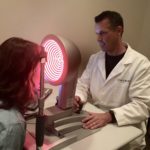As a surgeon, safety is my most important concern. I designed our patient care process to make laser vision correction as safe as possible. I’ve learned the best way to avoid problems is to carefully evaluate my patients prior to surgery, use ultra-modern technology, use meticulous surgical technique, and to be personally involved in the care of my patients. Read more about LASIK Safety.

Safety-first. We’ve told over 9,000 people to NOT have a procedure.
Being bothered by “Dry Eyes” is one the most common problems that I treat in my ophthalmology practice, especially during the initial healing phase after a procedure. Luckily, when managed systematically and proactively, these symptoms should be temporary and easy to treat. For more detailed info, read: ‘LASIK & Dry Eyes’
People that had LASIK many years ago commonly described seeing halos or glare at night. More advanced technology has greatly reduced the incidence and severity of these problems. With modern LASIK technology, studies show that it is ten-times more likely for patients to see better at night after LASIK than they did before LASIK with glasses/contacts. To read about this topic, read: ‘LASIK & Night Vision’
For most patients, it’s a very realistic goal to eliminate one’s dependence on glasses & contacts. But, if a patient has any residual prescription after their procedure, a re-treatment procedure can be considered to fine-tune one’s vision. There is a higher likelihood of needing a re-treatment in patients that have a larger correction, especially over 8 diopters. Improvements in techniques have reduced the possibility of a re-treatment to about 2% to 4% for typical corrections, which is included as part of the initial procedure cost. I make every effort to “get vision right” the first time.

Here’s an old picture of me in medical school when I used to wear glasses. I had LASIK in 2000.
After LASIK, other age-related eye changes may eventually occur that can cause vision to decline after LASIK. Just like you wouldn’t expect a new prescription of glasses or contacts to keep vision perfectly clear forever, you should understand that your vision may decline years after LASIK too. Studies have shown that LASIK can result in clear vision for an average of about 10-12 years. If/when your vision ever worsens with age, we have set up our “Extended Vision Plan“ to fine-tune your vision for your peace of mind.
For patients who are over 40, you should become familiar with the natural age-related condition, called Dysfunctional Lens Syndrome or Presbyopia, in which one’s near vision begins to gradually worsen with age. If you use bifocals, trifocals, progressive lenses, reading glasses or need to take off your distance glasses for close work, read: “LASIK & Near Vision”
You should do your own cost comparison between the amount you currently spend on “glasses, contacts, supplies and optometric fees” each year vs. the amount you’d spend for a one-time procedure (As a reference, average cost for reputable surgeons is approximately $5,000 total for both eyes). To learn when you’ll break even by having Modern Vision Correction, you can use our LASIK Affordability Calculator. Most patients break even between 5-7 years, making Modern LASIK the most cost-effective and sustainable method for vision correction available.
Please talk to your friends or family members that have had a vision correction procedure, as this is usually reassuring to you hear others describe their experience. There isn’t another procedure in all of medicine that can compare to the safety and effectiveness of Modern LASIK procedures. Clinical trials on LASIK conducted for the United States FDA demonstrated that:
Since not everyone is a candidate for LASIK, we’ll help determine if another related procedure, such as Epi-LASIK/PRK, SMILE, Visian ICL, or Custom Lens Replacement would be a better fit for you.
606 Saratoga Ave,
San Jose, CA 95129
5790 Stoneridge Mall Rd, Pleasanton, CA 94588